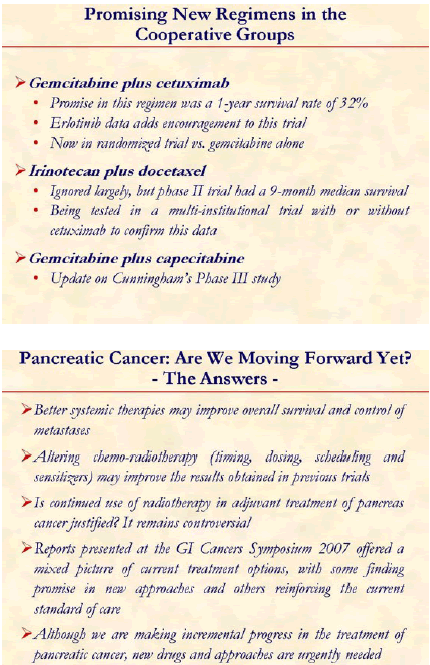- (2007) Volume 8, Issue 2
Muhammad Wasif Saif
Yale University School of Medicine. New Haven, CT, USA
bevacizumab; cetuximab; Chemotherapy, Adjuvant; Epidermal Growth Factor; erlotinib; Fluorouracil; gemcitabine; oxaliplatin; Pancreatic Neoplasms; Paclitaxel; Radiation; Radiotherapy, Adjuvant; S 1 (combination); sorafenib; Vascular Endothelial Growth Factor A
ASCO: American Society of Clinical Oncology; CALGB: Cancer and Leukemia Group B; CONKO: Charité Onkologie - clinical studies in GI cancers; ECOG: Eastern Cooperative Oncology Group; ESPAC: European Study Group of GITSG: Gastrointestinal Tumor Study Group; Pancreatic Cancer; LN: lymph nodes; LNR: ratio of metastatic to examined lymph nodes; RECIST: Response Evaluation Criteria in Solid Tumors
Survival for patients with pancreatic cancer remains abysmal. Standard treatment for resected and locally advanced disease usually consists of 5-fluorouracil (5-FU, either bolus or continuous infusion) and external beam radiation. However, recent studies have shown the role of gemcitabine either used alone or incorporated with 5-FU and external beam radiation in this setting. Gemcitabine and erlotinib (Tarceva®) are currently the only standard chemotherapeutic agents approved by FDA for the treatment of advanced pancreatic cancer. Combination chemotherapy trials incorporating gemcitabine with other agents such as 5-FU, oxaliplatin, or capecitabine generally show improved outcomes in objective response rates but with little or no improvement in survival in phase III trials. In this article, the author summarizes the key studies in pancreatic cancer presented at the 2007 Gastrointestinal Cancers Symposium (Orlando, FL, USA; January, 2007). The studies discussed here include preliminary results of the Cancer and Leukemia Group B (CALGB) phase III trial of gemcitabine plus bevacizumab and activity of other targeted agents including sorafenib, cetuximab, retrospective and populationbased studies evaluating the role of chemoradiotherapy and radiotherapy, an analysis of 3,306 patients from the Surveillance, Epidemiology and End Results (SEER) database evaluating the predictive role of lymph nodes in survival following pancreatectomy and the assessment of novel agents, such as Genexol-PM® and S-1.
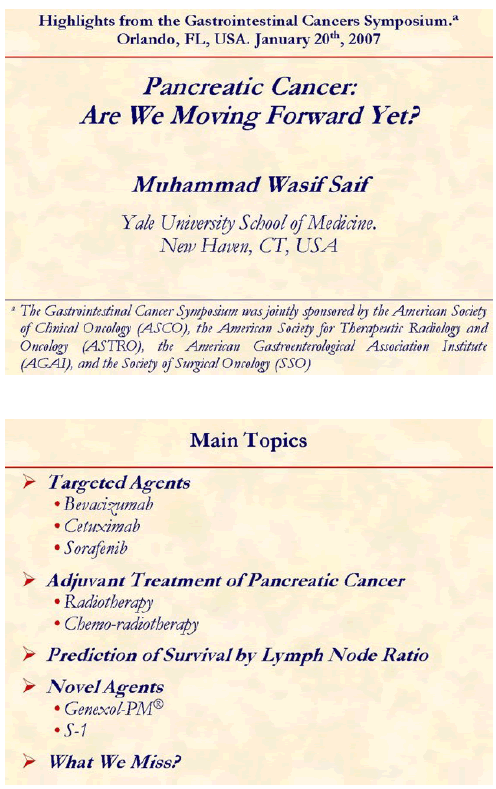
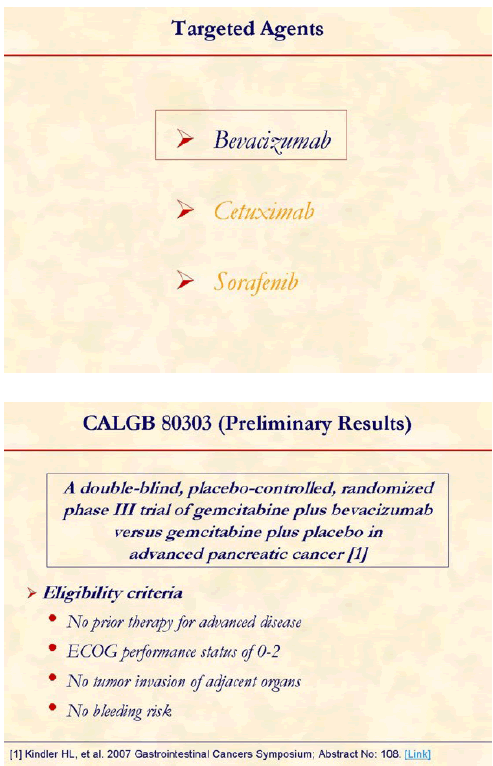
Preliminary results of the Cancer and Leukemia Group B (CALGB) 80303 study - which is a double-blind, placebo-controlled, randomized phase III trial of gemcitabine plus bevacizumab versus gemcitabine plus placebo in patients with advanced pancreatic cancer - were presented by Dr. Kindler [1].
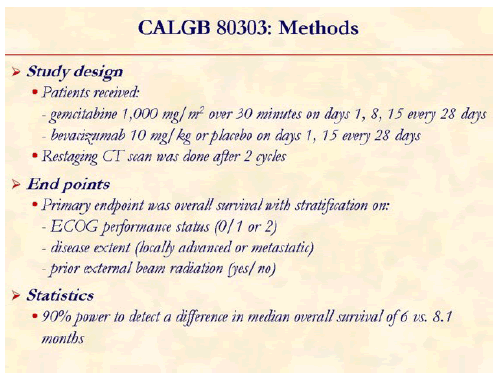
The patients were administered gemcitabine 1,000 mg/m2 over 30 minutes on days 1, 8, 15 every 28 days, bevacizumab 10 mg/kg or placebo on day 1, 15 every 28 days. Restaging CT scan was done after two cycles.
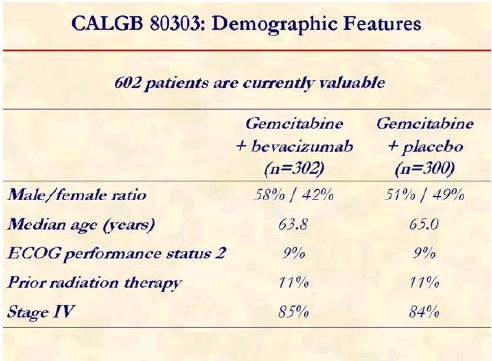
Demographic characteristics of both arms were well-balanced.
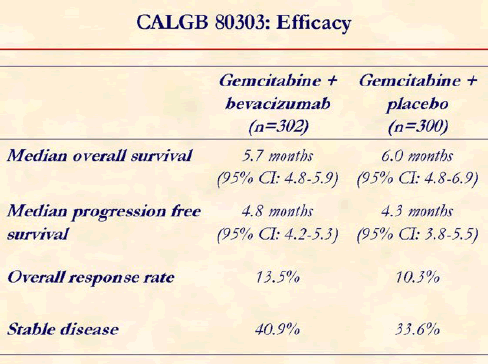
Median follow-up was 8.4 and 8.1 months for gemcitabine plus bevacizumab and gemcitabine plus placebo arms, respectively. As of August 2006, 377 patients (196 and 181 for each arm, respectively) have died (80% of total expected deaths at the planned final analysis).
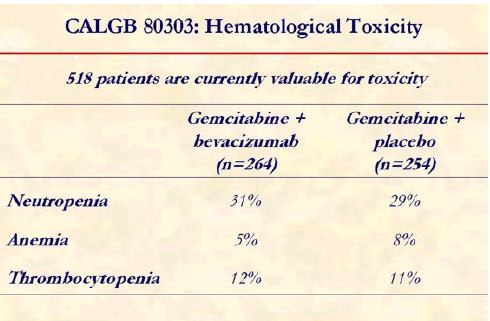
Hematological (gemcitabine) toxicity was equal on both arms.
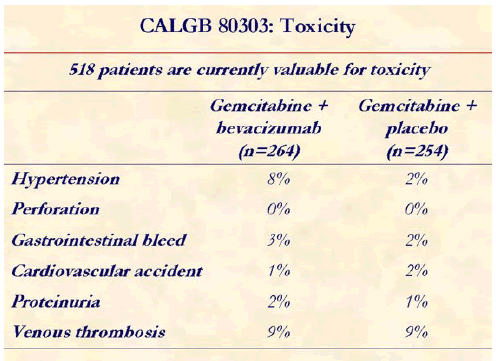
Hypertension and proteinuria were more common on the bevacizumab arm compared to the placebo arm.
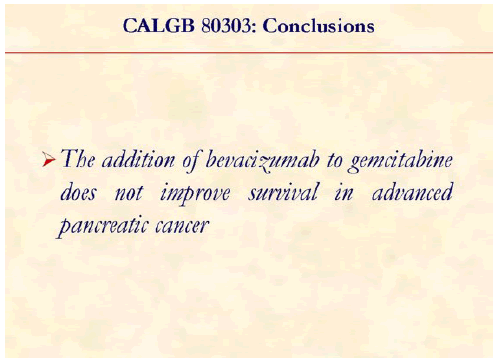
This double-blind, placebo-controlled, randomized phase III trial of gemcitabine plus bevacizumab versus gemcitabine plus placebo in patients with advanced pancreatic cancer did not show any survival benefit of adding bevacizumab to gemcitabine.
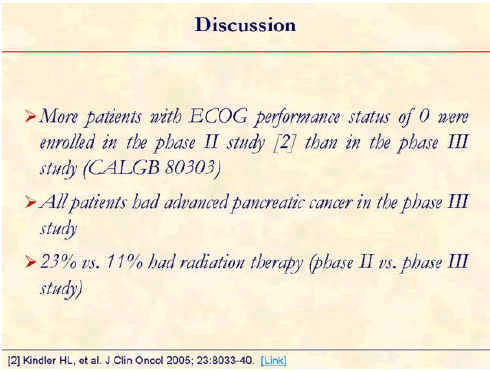
In spite the encouraging results of phase II study [2], the phase III study failed to show any benefit of adding bevacizumab to gemcitabine. The demographic characteristics of both arms were balanced. As well as, this was a well-powered study. Moreover, the study was rationale-based.
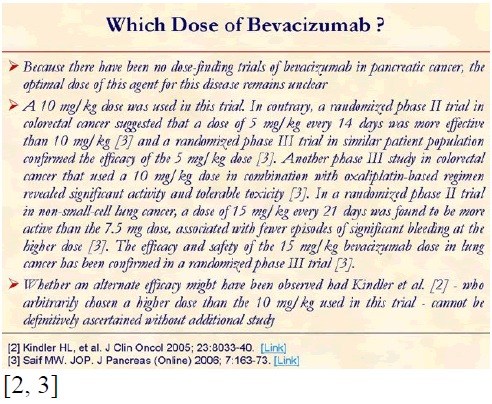
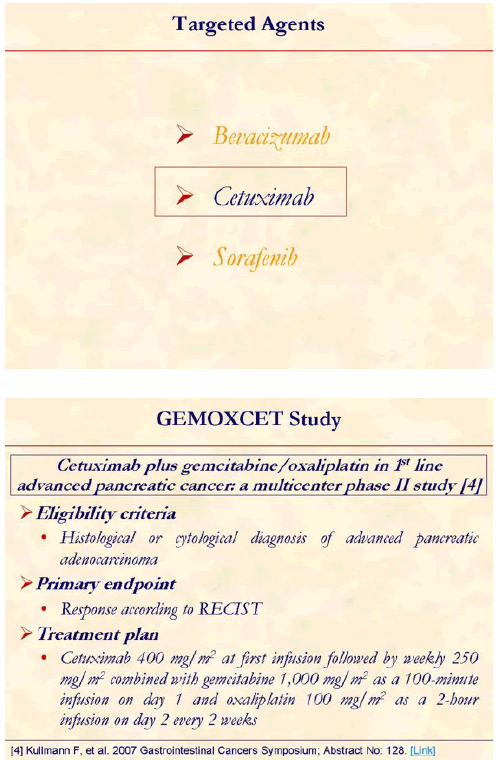
Targeting the epidermal growth factor receptor pathway with agents such as cetuximab, a chimeric antibody, is an attractive therapeutic approach in the management of pancreatic cancer. [4]
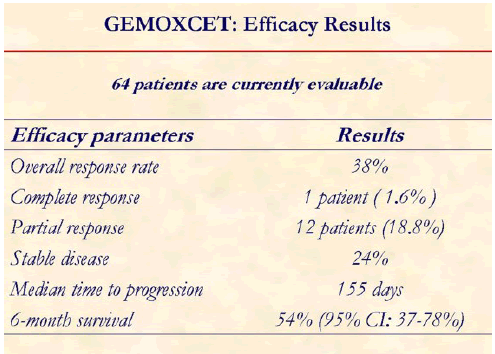
The addition of cetuximab to the combination of gemcitabine and oxaliplatin exhibited a high response rate of 38%, with a 54% 6- month survival.
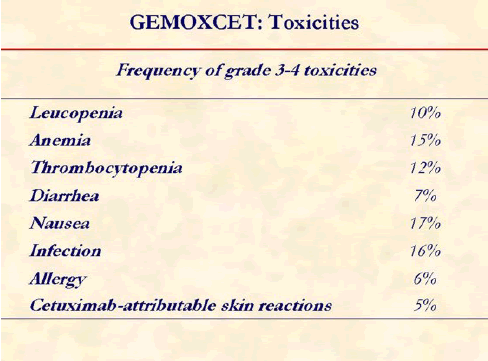
The addition of cetuximab to the gemcitabine plus oxaliplatin regimen was well tolerated.
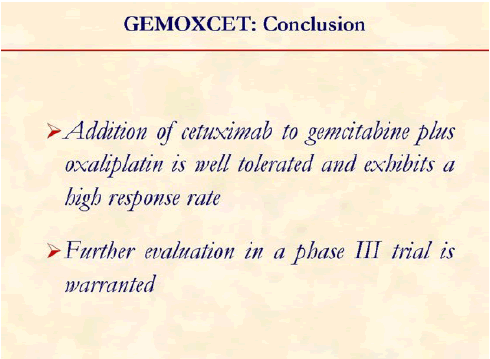
Addition of cetuximab to gemcitabine plus oxaliplatin is well tolerated and showed a high response rate. Further evaluation in a phase III trial is warranted.
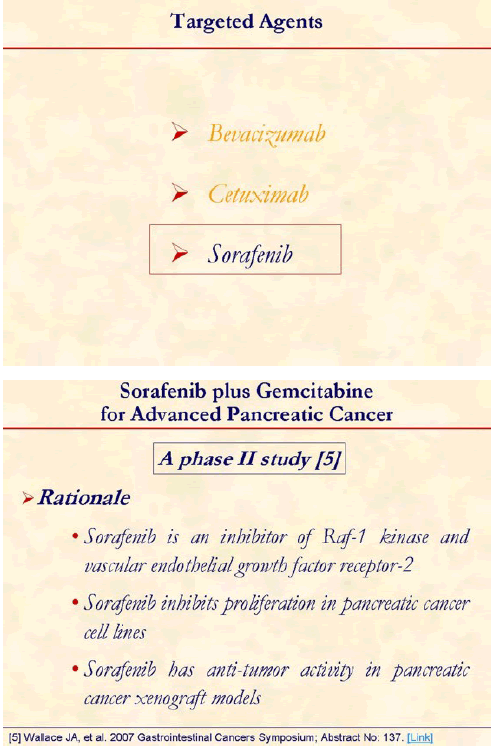
Sorafenib is a small molecular that inhibit Raf kinase, PDGF (platelet-derived growth factor) and VEGF (vascular endothelial growth factor) receptor kinase. With its potent inhibitory effects against Raf-1 kinase and vascular endothelial growth factor receptor-2, sorafenib is a novel oral anticancer agent targeting signal transduction and angiogenic pathways. [5]
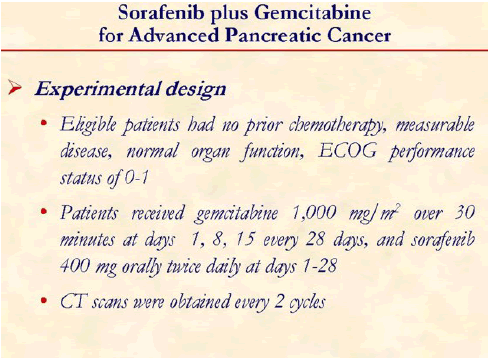
Sorafenib is administered continuously, whereas gemcitabine is given at 1,000 mg/m2 weekly at days 1, 8, 15 every 4 weeks.
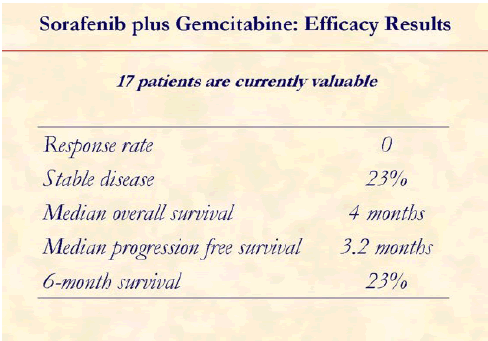
Gemcitabine plus sorafenib showed no objective responses.
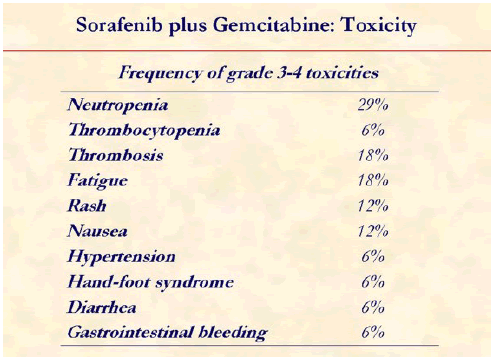
No episode of neutropenic fever was observed.
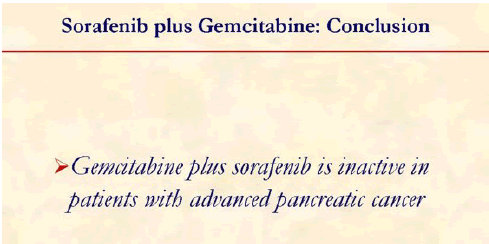
Although the combination was well tolerated, gemcitabine plus sorafenib is inactive in advanced pancreatic cancer.
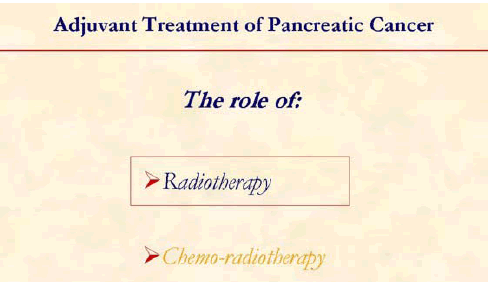
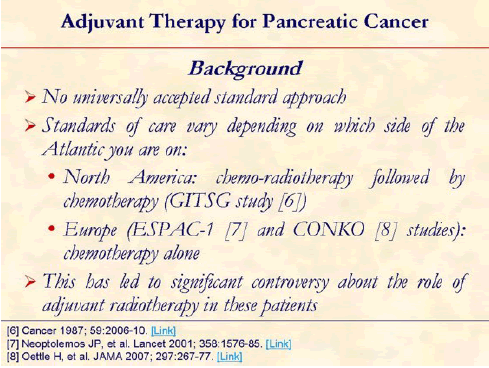
Early studies, such GITSG [6] have shown a benefit of adjuvant chemo-radiotherapy after surgical resection of pancreatic cancer. However, recent trials, such as ESPAC-1 [7] and CONKO [8] have shown a benefit of adjuvant chemotherapy while showing a negative effect with the addition of radiotherapy. This has led to significant controversy about the role of adjuvant radiotherapy in these patients.
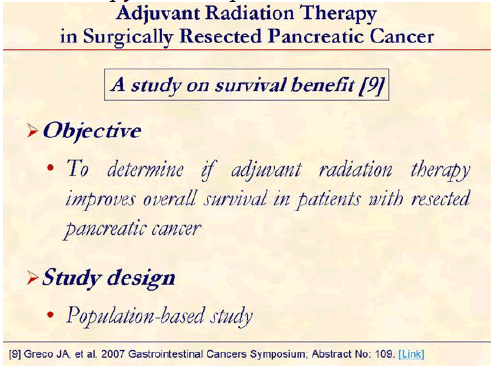
The primary aim of this population-based study was to determine if adjuvant radiotherapy improves overall survival in patients with resected pancreatic cancer [9].
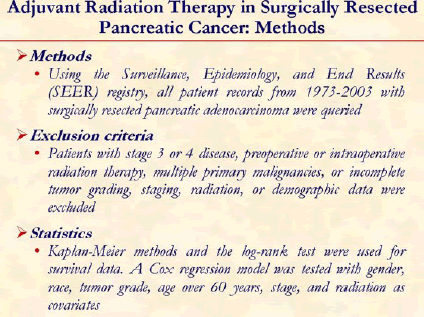
Using the Surveillance, Epidemiology, and End Results (SEER) registry, all patient records from 1973-2003 with surgically resected pancreatic adenocarcinoma were queried.
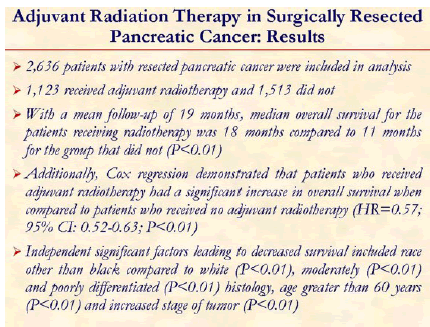
The data demonstrated that patients who received adjuvant radiation therapy had a statistically significant increase in overall survival when compared to patients who received no adjuvant radiation therapy.
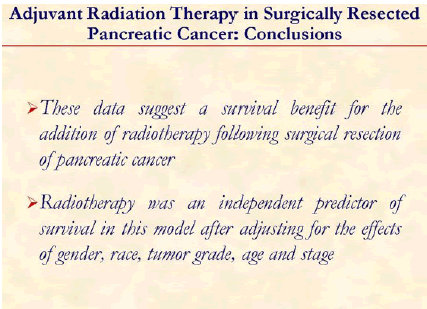
These data suggest a survival benefit for the addition of radiotherapy following surgical resection of pancreatic adenocarcinoma.
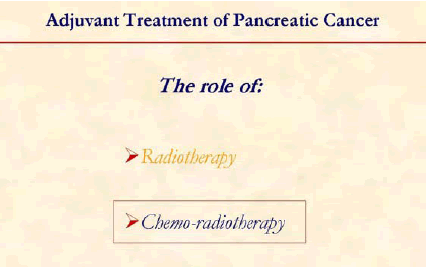
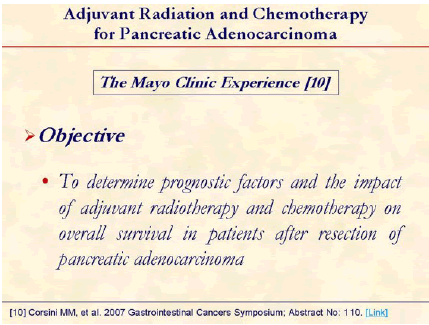
The study aimed to determine the impact of adjuvant radiotherapy and chemotherapy on overall survival in patients after resection of pancreatic adenocarcinoma [10].
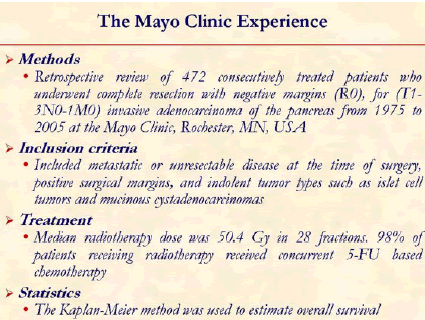
A retrospective review of 472 consecutively treated patients who underwent complete resection with negative margins (R0), for (T1- 3N0-1M0) invasive adenocarcinoma of the pancreas from 1975 to 2005 at the Mayo Clinic, Rochester, MN, USA was performed.
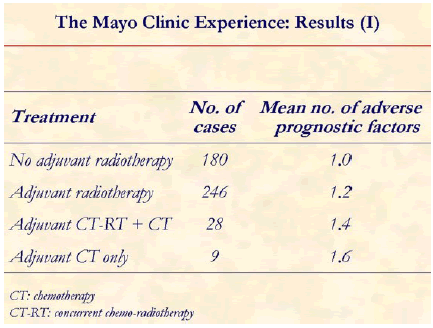
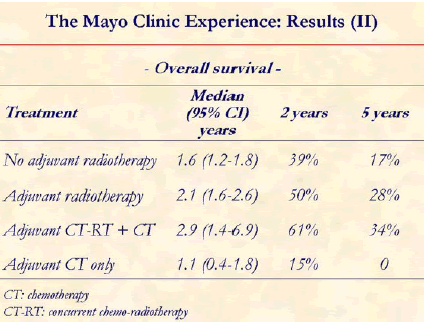
Median follow-up was 2.7 years in surviving patients. Median overall survival for patients receiving adjuvant concurrent chemoradiotherapy was 2.1 years vs. 1.6 years for those not receiving adjuvant radiotherapy (P=0.001).
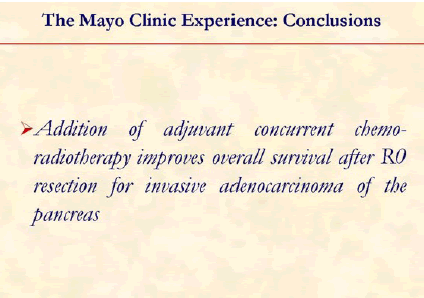
This large, single institution retrospective study series suggests that the addition of adjuvant chemo-radiotherapy improves overall survival after R0 resection for invasive adenocarcinoma of the pancreas.
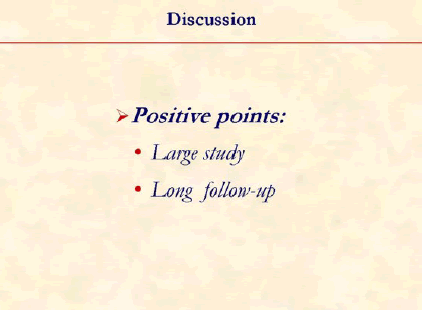
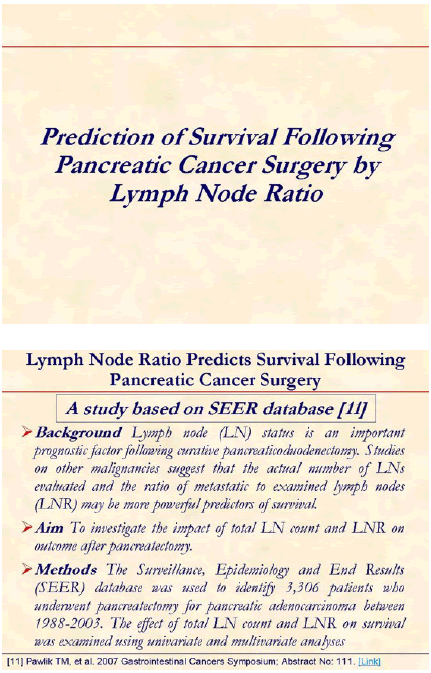
For predicting survival after pancreatic cancer surgery, the ratio of metastatic to examined nodes might be more accurate than the absolute number of metastatic nodes sampled. Pawlik et al. [11] reported that the number of lymph nodes examined was also predictive of survival in an analysis of 3,306 patients from the Surveillance, Epidemiology and End Results (SEER) database.
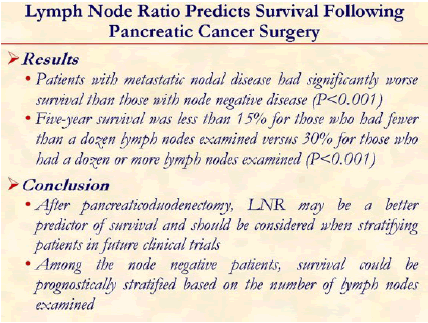
• Median number of LNs examined was 6; 677 (20%) patients had zero LNs examined. Of the 2,629 patients who had LNs examined, 1,068 (41%) had no LN metastases (N0) and 1,561 (59%) had metastatic nodal disease (N1). Median survival was 12 months and 5- year survival was 15%.
• On multivariate analysis, prognostic factors included tumor stage, grade, tumor size greater than 2 cm, number of LNs examined, LNR, and N1 disease (all P<0.05). Specifically, 5-year survival of patients with N1 disease (7%) was worse compared with patients who had N0 disease (18%) (P<0.001).
• Patients with N0 disease could be further prognostically stratified based on the number of LNs evaluated (5-year survival: 15% in less than 12 LNs vs. 30% in 12 or more LNs; P<0.001).
• Even after adjusting for other competing risk factors, an increase in LNR was correlated with decreased survival (HR=2.5, P<0.001).
• As the LNR increased median survival decreased (LNR 0: 17 months; LNR greater than 0 to 0.2: 16 months; LNR greater than 0.2 to 0.4: 13 months; LNR greater than 0.4: 10 months; P<0.001).
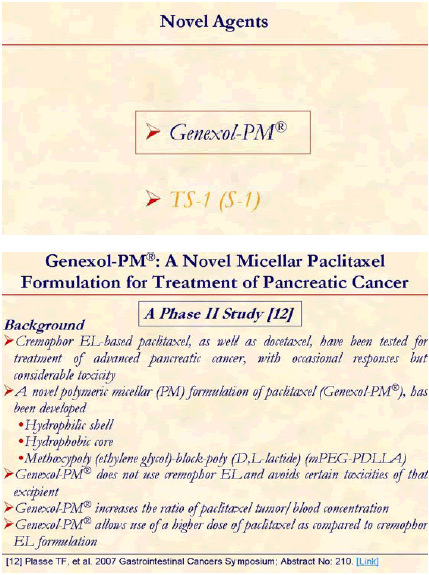
Genexol-PM® is a novel micellar formulation of paclitaxel in a low molecular weight biodegradable synthetic polymer [12]. Substitution of cremophor EL by patented bioabsorbable polymer results in changes in pharmacokinetic behavior of paclitaxel:
• higher maximally tolerated dose value;
• lower toxicity.
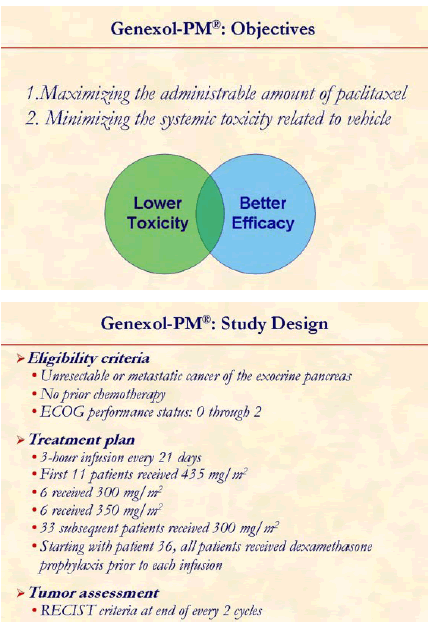
Patients with measurable disease, ECOG PS less than or equal to 2, no prior chemotherapy, and adequate organ function received 3-hour infusion of Genexol-PM® every 21 days.
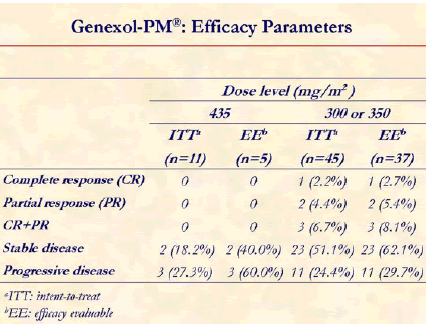
The results are promising and comparable to single agent gemcitabine.
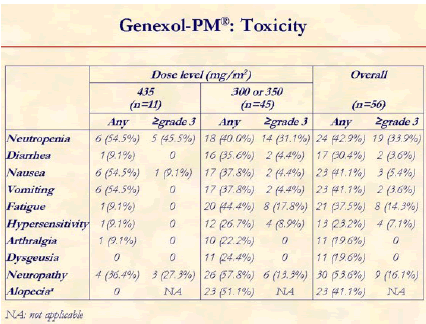
Toxicities were generally those expected with paclitaxel and were manageable with standard supportive measures.
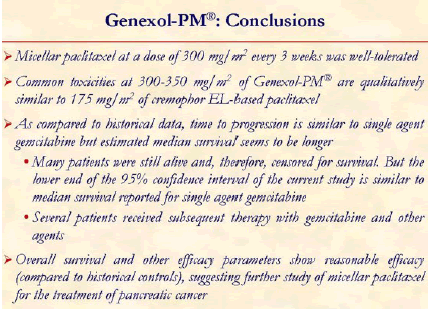
Genexol-PM® was generally well-tolerated in patients with advanced pancreatic cancer and resulted in progression-free survival similar to that seen historically with gemcitabine. Further evaluation of this agent in combination with gemcitabine is warranted.
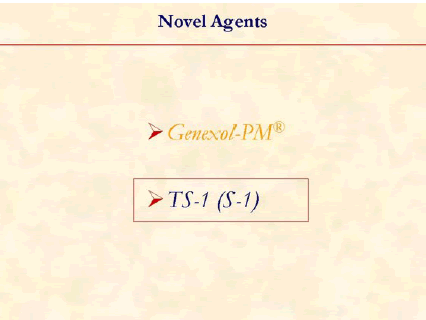
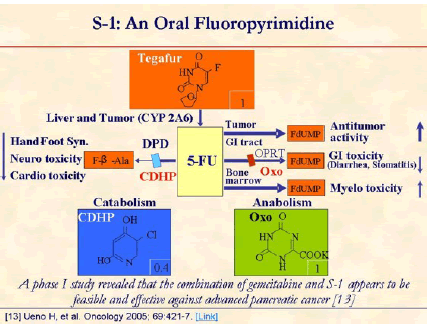
S-1 is a new oral formulation consisting of 1 M tegafur, 0.4 M gimeracil and 1 M oteracil potassium. S-1 was developed by the scientific theory of both potentiating antitumor activity of 5-fluorouracil (5-FU) and reducing gastrointestinal toxicity induced by 5-FU. A phase I study previously published [13] revealed that the combination of gemcitabine and S-1 appears to be feasible and effective against advanced pancreatic cancer.
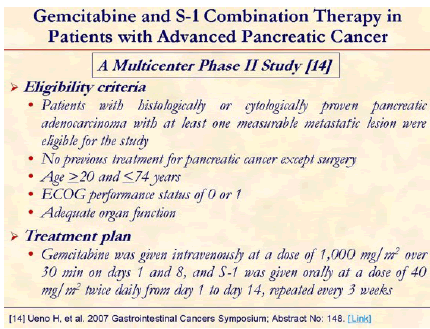
The phase I study previously published [13] led to a multicenter phase II study which was recently presented at the Gastrointestinal Cancers Symposium, 2007 [14].
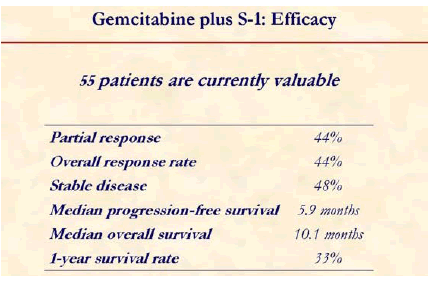
Gemcitabine plus S-1 therapy showed a high response rate (44%).
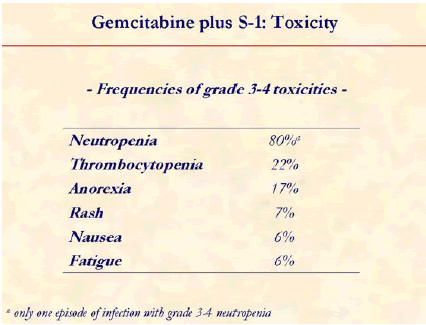
Gemcitabine plus S-1 regimen has acceptable toxicity profile in patients with advanced pancreatic cancer.
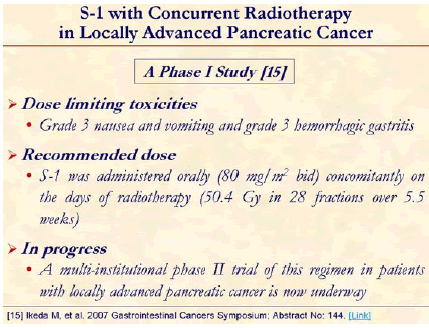
A phase I study investigated the maximumtolerated dose of S-1 based on the frequency of dose-limiting toxicities (DLT) of S-1 with concurrent radiotherapy in patients with locally advanced pancreatic cancer [15]. Twenty-one patients (50 mg/m2: 3 patients, 60 mg/m2: 5 patients, 70 mg/m2: 6 patients, 80 mg/m2: 7 patients) were enrolled in this trial. The recommended dose of S-1 therapy with concurrent radiotherapy was 80 mg/m2. A multi-institutional phase II trial of this regimen in patients with locally advanced pancreatic cancer is now underway.

